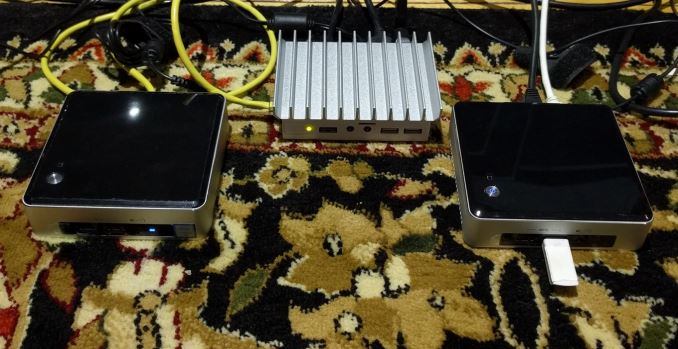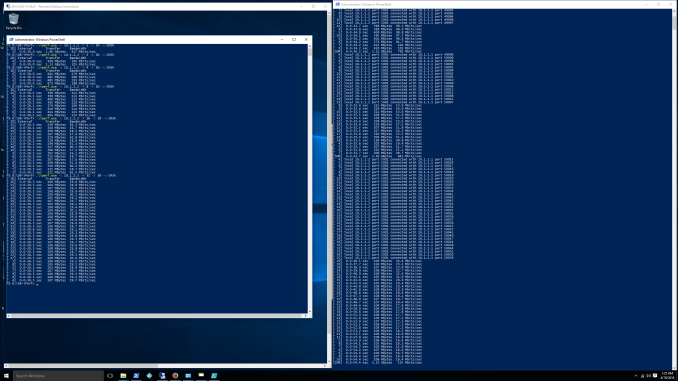Compulab fitlet-XA10-LAN Review: A Fanless AMD UCFF PC for Networking Applications
by Ganesh T S on April 19, 2016 8:00 AM EST- Posted in
- Systems
- Networking
- AMD
- Fanless
- Industrial PC
- Passive Cooling
- CompuLab
Networking Benchmarks
The configuration of the fitlet-XA10-LAN makes it ideal for use in networking applications. Typical uses include operation as a dedicated router, or a firewall appliance (using pfSense or VyOS), or even just generating network traffic for evaluation of other components in the network. Many use-cases can also be served with a standard Linux Mint installation.
Detailed benchmarking of the unit for a particular network application is beyond the scope of this review. However, we did install VyOS on the machine to test out its capabilities as a router. VyOS had no trouble recognizing the USB WLAN adapter and the four Intel NICs. We configured the unit as described in the Quick Start Guide of the official manual. eth3 was configured as the WAN interface. eth0 was configured as a LAN interface. The NAT, DHCP server, DNS forwarder and firewall policies were set up as indicated in the above guide.
Even though plenty of benchmarks can be run for this router configuration, we decided to focus on NAT throughput with the default configuration. In order to test that aspect, we configured a NUC to act as a DHCP server on its wired interface. This wired interface was connected to the WAN port of the VyOS fitlet. The NUC itself was set to a static IP (10.1.1.2) and it gave the VyOS fitlet an IP address of 10.1.1.1.
The fitlet's LAN port was connected to another NUC, and it received an IP address in the configured subnet (192.168.50.0/24). iperf was used to track throughput across the NAT, with the WAN machine acting as a server and the LAN machine acting as a client.
Since the WLAN interface of the NUCs was connected to our default network, we could log on via Remote Desktop to process the iperf commands.
In terms of performance, the fitlet-XA10-LAN was able to route a respectable 843 Mbps across the NAT in the above-mentioned configuration. The fitlet-XA10-LAN with two active LAN interfaces idled at around 9W. When routing at full rate across the two network interfaces, the power consumption peaked at around 15W.
The Intel NICs and the powerful 'unlocked' AMD SoC ensure that the fitlet-XA10-LAN is a powerful network appliance in a compact form factor.












50 Comments
View All Comments
ganeshts - Wednesday, April 20, 2016 - link
I was a bit surprised too, but, I think the reason is that the ERL might have hardware acceleration for NAT. On the other side, this is a full-fledged PC. It can do a lot more than just routing / I expect consumers might want to run more CPU-intensive network-related tasks in addition to routing duties.freeskier93 - Wednesday, April 20, 2016 - link
EdgeOS is Debian based and supports apt-get so you can install other things on it. Although it did bog down our connection a bit when someone was connected, our ERL ran OpenVPN good enough for occasional use.easp - Wednesday, April 20, 2016 - link
Not a big surprise, considering that ERL has hardware acceleration + tailored/optimized firmware. People running OpenWRT are often able to get a 50% boost out of much more modest with a bit of tuning of kernel parameters, so chances are, a little tweaking of the config would get closer to the max.trane - Wednesday, April 20, 2016 - link
A10 Micro 6700T may be the most underrated SoC in history. A couple of years back when it first released it was faster than Bay Trail across the board, and destroyed it for GPU performance. The Discovery tablet had good battery life too - I suspect within an hour or so of Bay Trail. Sadly, it got ambushed by Intel's Bay Trail contra revenues. Is this the first commercial design for it?It's surprising that it's still faster than Intel's latest 14nm Braswell, despite being on 28nm. Though yes, it does use a cTDP up.
I look forward to see dual-core low power Zen APUs in this market.
yannigr2 - Wednesday, April 20, 2016 - link
I was curious reading a review of this for over a year. Well, better late than never.Compulab - Wednesday, April 20, 2016 - link
Actually it was Compulab who held back the review. We had to improve the thermal characteristics of the product. Designing the heatsink and new metal panels and coating took a while.I think that the review reflects correctly the capabilities of fitlet, something we could not achieve sooner.
ely105 - Tuesday, June 28, 2016 - link
When you order the fitlet-LAN from amazon, does it have the new/improved black coating?serendip - Wednesday, April 20, 2016 - link
An x86 SOC that runs Linux out of the box? I think I just saw a unicorn. Too bad AMD couldn't push the Mullins chips to tablet makers. I'm stuck with an Atom tablet that will probably never run Linux with full support, thanks to 32-bit UEFI nonsense and closed source drivers.Compulab - Wednesday, April 20, 2016 - link
Actually Compulab (together with Linux Mint) has been offering pre-installed "MintBox" for several years now, including MintBox Mini based on fitlet.See http://www.fit-pc.com/web/products/mintbox/
2disbetter - Thursday, April 28, 2016 - link
Ganesh, thanks for writing this up. It was the first bit of exposure I've had with Compulab, and I'm very happy I found out about them. Their Airtop and Fitlab models are both very interesting products. Very very interesting.